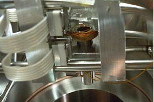

Friday - May 22, 2009
SLAC Today is
available online at:
http://today.slac.stanford.edu
In this issue:
From the Director: Planning It Right!
Symmetry Logbook: Violating Parity
Word of the Week: Kelvin
 |
 |
|
Friday - May 22, 2009 |
From the Director: Planning It Right!Good work planning and control is an essential process at SLAC that allows us to deliver the lab's mission with high quality and outstanding safety. Over the past two years, the lab as a whole has put a lot of effort into improving the work planning and control processes, or WPC, and I am happy to see genuine progress as Integrated Safety Management becomes real at SLAC. The message that proper work planning and control are integral to successful completion of our work and mission cannot be over emphasized. Good work planning and safety come before schedule without question or qualification. So I start there. However, I've just taken the new WPC training that many of you are participating in, and I like the new framework that is being put in place. I like the concepts of authorization of work and release of work. This is new language to describe what many of you have been doing for years, but now we have a common vocabulary, a common understanding, and a common system. Authorization of work is done by your supervisor, who knows the kind of work you are qualified to do and makes sure you have the right training and the right tools. Release of work comes from the area manager or building manager, who understands the complexity of the day's activities at a given site. Read more... Symmetry Logbook: Violating ParityThis doodle pad was used by Columbia University researcher Tsung-Dao (T.D.) Lee during talks with Chen Ning (Frank) Yang, while they were visiting scientists at Brookhaven National Laboratory in the summer of 1956. The two theoretical physicists, both Chinese emigrants, frequent collaborators and long-time friends, met twice a week to break down a fundamental and supposedly absolute law of physics known as parity conservation. Parity is a type of symmetry encountered in nuclear and particle physics. It is denoted by the symbol "P," scribbled throughout the researchers' note pad. Parity is conserved when the laws of physics for a system of elementary particles remain the same if the positions and directions of all the particles are reversed. Physicists once believed that nature was always symmetrical with respect to such a transformation, making parity conservation a well established principle in the field. Read more in Symmetry magazine...  A view into a vacuum chamber where MIT researchers
cooled sodium atoms to 500 picokelvin. The atoms where magnetically confined by the coil in the center.
(Photo: Ketterle lab, MIT)
Word of the Week: KelvinNamed for the British physicist who invented it, the Kelvin temperature scale puts warmth into perspective by starting from the coldest of cold, 0 kelvin—absolute zero—where even atoms' vibrations become still. Equivalent to -273.15 degrees Celsius, this theoretical absence of heat energy is unattainable in practice. Even the coldest depths of space measure around 3 kelvin. The known record lows have been set here on Earth, though. In 2003, researchers at MIT chilled sodium gas to a mere 500 trillionths of a kelvin. And researchers at Helsinki University of Technology's Low Temperature Lab used a process called nuclear magnetic ordering to cool a piece of rhodium metal to only 100 trillionths of a kelvin above absolute zero. |
Events
Access (see all)
Announcements
|
|
| | ||
|
|
||
 <%
Response.AddHeader "Last-modified", getArticleDate()
'Response.AddHeader "Last-modified","Mon, 01 Sep 1997 01:03:33 GMT"
'Monday, December 06, 2010
%>
<%
Response.AddHeader "Last-modified", getArticleDate()
'Response.AddHeader "Last-modified","Mon, 01 Sep 1997 01:03:33 GMT"
'Monday, December 06, 2010
%>View online at http://today.slac.stanford.edu/. |
||